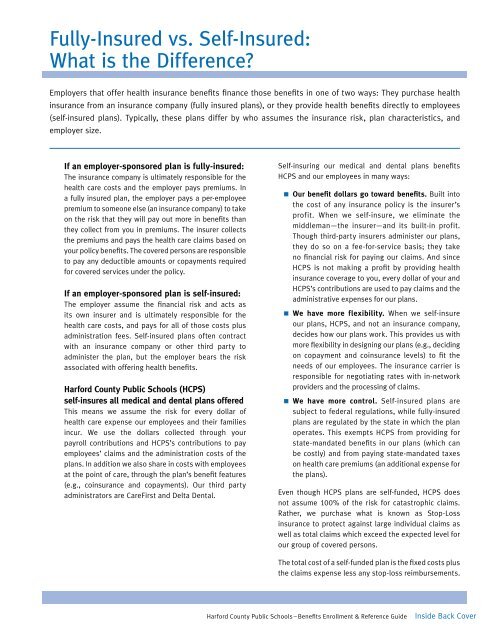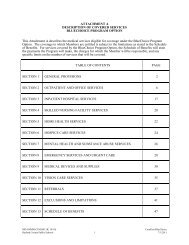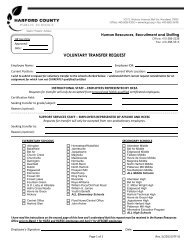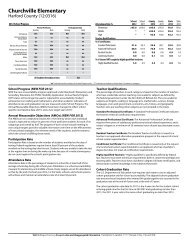Benefits Enrollment & Reference Guide - Harford County Public ...
Benefits Enrollment & Reference Guide - Harford County Public ...
Benefits Enrollment & Reference Guide - Harford County Public ...
You also want an ePaper? Increase the reach of your titles
YUMPU automatically turns print PDFs into web optimized ePapers that Google loves.
Fully-Insured vs. Self-Insured:<br />
What is the Difference?<br />
Employers that offer health insurance benefits finance those benefits in one of two ways: They purchase health<br />
insurance from an insurance company (fully insured plans), or they provide health benefits directly to employees<br />
(self-insured plans). Typically, these plans differ by who assumes the insurance risk, plan characteristics, and<br />
employer size.<br />
If an employer-sponsored plan is fully-insured:<br />
The insurance company is ultimately responsible for the<br />
health care costs and the employer pays premiums. In<br />
a fully insured plan, the employer pays a per-employee<br />
premium to someone else (an insurance company) to take<br />
on the risk that they will pay out more in benefits than<br />
they collect from you in premiums. The insurer collects<br />
the premiums and pays the health care claims based on<br />
your policy benefits. The covered persons are responsible<br />
to pay any deductible amounts or copayments required<br />
for covered services under the policy.<br />
If an employer-sponsored plan is self-insured:<br />
The employer assume the financial risk and acts as<br />
its own insurer and is ultimately responsible for the<br />
health care costs, and pays for all of those costs plus<br />
administration fees. Self-insured plans often contract<br />
with an insurance company or other third party to<br />
administer the plan, but the employer bears the risk<br />
associated with offering health benefits.<br />
<strong>Harford</strong> <strong>County</strong> <strong>Public</strong> Schools (HCPS)<br />
self-insures all medical and dental plans offered<br />
This means we assume the risk for every dollar of<br />
health care expense our employees and their families<br />
incur. We use the dollars collected through your<br />
payroll contributions and HCPS’s contributions to pay<br />
employees’ claims and the administration costs of the<br />
plans. In addition we also share in costs with employees<br />
at the point of care, through the plan’s benefit features<br />
(e.g., coinsurance and copayments). Our third party<br />
administrators are CareFirst and Delta Dental.<br />
Self-insuring our medical and dental plans benefits<br />
HCPS and our employees in many ways:<br />
Our benefit dollars go toward benefits. Built into<br />
the cost of any insurance policy is the insurer’s<br />
profit. When we self-insure, we eliminate the<br />
middleman—the insurer—and its built-in profit.<br />
Though third-party insurers administer our plans,<br />
they do so on a fee-for-service basis; they take<br />
no financial risk for paying our claims. And since<br />
HCPS is not making a profit by providing health<br />
insurance coverage to you, every dollar of your and<br />
HCPS’s contributions are used to pay claims and the<br />
administrative expenses for our plans.<br />
We have more flexibility. When we self-insure<br />
our plans, HCPS, and not an insurance company,<br />
decides how our plans work. This provides us with<br />
more flexibility in designing our plans (e.g., deciding<br />
on copayment and coinsurance levels) to fit the<br />
needs of our employees. The insurance carrier is<br />
responsible for negotiating rates with in-network<br />
providers and the processing of claims.<br />
We have more control. Self-insured plans are<br />
subject to federal regulations, while fully-insured<br />
plans are regulated by the state in which the plan<br />
operates. This exempts HCPS from providing for<br />
state-mandated benefits in our plans (which can<br />
be costly) and from paying state-mandated taxes<br />
on health care premiums (an additional expense for<br />
the plans).<br />
Even though HCPS plans are self-funded, HCPS does<br />
not assume 100% of the risk for catastrophic claims.<br />
Rather, we purchase what is known as Stop-Loss<br />
insurance to protect against large individual claims as<br />
well as total claims which exceed the expected level for<br />
our group of covered persons.<br />
The total cost of a self-funded plan is the fixed costs plus<br />
the claims expense less any stop-loss reimbursements.<br />
<strong>Harford</strong> <strong>County</strong> <strong>Public</strong> Schools – <strong>Benefits</strong> <strong>Enrollment</strong> & <strong>Reference</strong> <strong>Guide</strong> Inside Back Cover

















